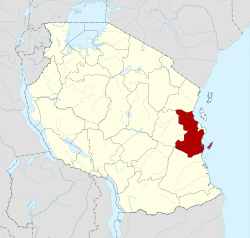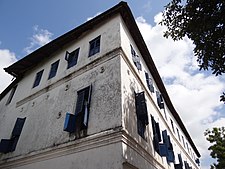
Rufiji is one of the six districts of the Pwani Region of Tanzania. It is bordered to the north by the Kisarawe and Mkuranga Districts, to the east by the Indian Ocean, to the south by the Kilwa District, Lindi Region and to the west by the Morogoro Region. The district capital is the town of Utete on the southern banks of the Rufiji River.

Kilwa District is one of six administrative districts of Lindi Region in Tanzania. The District covers an area of 15,000 km2 (5,800 sq mi). The district is comparable in size to the land area of the nation state of East Timor. Kilwa district is bordered to the north by Rufiji District in Pwani Region, to the east by the Indian Ocean, to the south by the Lindi District, Nachingwea District together with Ruangwa District, and to the west by the Liwale District. The district borders every other district in Lindi Region except Lindi Municipal District. The district seat (capital) is the town of Kilwa Masoko. The district is named after the medieval Swahili city state of Kilwa Kisiwani. According to the 2012 census, the district has a total population of 190,744.

Lindi Region is one of Tanzania's 31 administrative regions. The region covers an area of 66,040 km2 (25,500 sq mi). The region is comparable in size to the combined land area of the nation state of Sri Lanka. The regional capital is the municipality of Lindi.

Bagamoyo District Council is one of eight administrative districts of Pwani Region in Tanzania. The District covers an area of 945 km2 (365 sq mi). The district is surrounded by the Chalinze District to the north and west, the Zanzibar Channel to the east, the Kibaha District to the south, and the Kinondoni District to the south-east in the Dar es Salaam Region. The district is comparable in size to the land area of Turks and Caicos Islands. The district capital is at Bagamoyo. 1n 2016 the Tanzania National Bureau of Statistics report there were 106,484 people in the district, from 311,740 in 2012, of which 97,660 where in current district wards. The decrease being from splitting of the district and creation of the Chalinze District in 2015.

Kisarawe District Council is one of eight administrative districts of Pwani Region in Tanzania. The District covers an area of 5,031 km2 (1,942 sq mi). It is bordered to the east by Dar es Salaam Region's Ilala and Ubungo Municipal Councils. The Kibaha District and Kibaha Town Council border the district to the north, and the Mkuranga District and Kibiti District border it to the south-east. By the Rufiji District to the south, and the Morogoro District of the Morogoro Region to the west. The district is comparable in size to the land area of Trinidad and Tobago. The town of Kisarawe serves as its administrative capital. According to the 2012 Tanzania National Census, the population of the District was 101,598.

The Kwere also known as Ngh'wele are a matrilineal ethnic and linguistic group native to Bagamoyo District and Chalinze District in Pwani Region of coastal Tanzania. The primary language spoken is Ngh'wele, called Kikwere in Swahili. The most famous person of Kwere descent is former President of Tanzania Jakaya Kikwete.
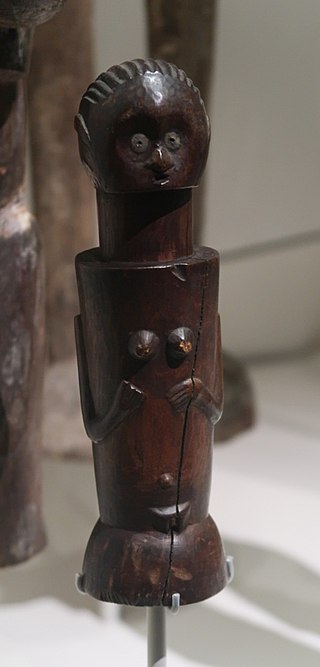
The Doe are an ethnic and linguistic group based in northern coastal Tanzania, in the Bagamoyo District and Chalinze District of Pwani Region. In 1987 the Doe population was estimated to number 24,000.

The following outline is provided as an overview of and topical guide to Tanzania:

Chanika is an administrative ward of the Ilala Municipical Council of the Dar es Salaam Region in Tanzania. Majohe ward encircles the ward on its northern edge. Tambani Ward of the Mkuranga District in the Pwani Region lies to the south, while Msongola is to the east. The Msimbu and Kisarawe wards of the Kisarawe District in the Pwani Region are also to the west. According to the 2012 census, the ward has a total population of 43,912.
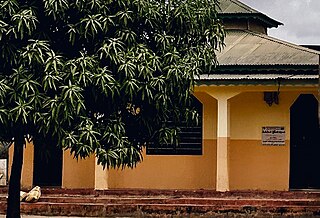
Kisarawe II or unofficially East Kisarawe is an administrative ward in the Kigamboni district of the Dar es Salaam Region of Tanzania. The Kibada and Mjimwema form the ward's northern border. East is Somangila. Pembamnazi borders it to the south. Toangoma in the Temeke District, as well as Vianzi and Vikindu in the Pwani Region's Mkuranga District, border the west. Since Kisarawe II is the district's top agricultural producer, it is known as Kigamboni's "ricebowl" and "food basket". In 2016 the Tanzania National Bureau of Statistics report there were 10,401 people in the ward, from 8,306 in 2012.

Toangoma is an administrative ward in the Temeke district of the Dar es Salaam Region of Tanzania. Kijichi and Kibada, the latter of which is a ward of Kigamboni MC, form the ward's northern and western boundaries. The west the ward is bordered by Mianzini and Mbagala Kuu. The ward is bordered to the east by Kisarawe II of Kigamboni MC. The ward is bordered to the south by the Pwani Region's Tambani and Vikindu. According to the 2012 census, the ward has a total population of 44,578.
Kisarawe is a Tanzanian district that is the larger settlement of the Pugu Hills, southwest of Dar es Salaam. In the Kisarawe district there is an 8200-hectares cultivation of Jatropha shrubs that are processed to produce biodiesel.
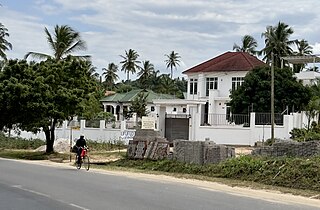
Pugu is an administrative ward of the Ilala Municipical Council of the Dar es Salaam Region in Tanzania. Kinyerezi and Kwembe ward of Kinondoni MC form the ward's northern boundary. The ward is bordered by Majohe to the south and Gongolamboto to the east. In the west the ward is bordered by Kisarawe ward of Kisarawe District in the Pwani Region. The ward is named after the Pugu Hills, which form its western border and are home to the Pugu Hills Forest Reserve and the Kazimzumbwi Forest Reserve, two of some of the world's oldest forests. According to the 2012 census, the ward has a total population of 49,422.
Zaramo is a Niger-Congo language, formerly primary language of the Zaramo people of eastern Tanzania. Zaramo is also known as Zalamo, Kizaramo, Dzalamo, Zaramu, Saramo and, Myagatwa. The language is critically endangered. The ethnic population of the Zaramo people reaches about 200,000, yet there are only a few elderly speakers remaining.

Kibaha is one of nine administrative districts of Pwani Region in Tanzania. The name means '"it is here" in Zaramo. The District covers an area of 1,502 km2 (580 sq mi). Kibaha District is bordered to the northeast by Kibaha Urban District and the north by Chalinze District. The district is bordered to the southeast by the Kisarawe District, On the western side the district is borderd by Morogoro District of Morogoro Region. The district seat (capital) is the town and ward of Mlandizi. According to the 2012 census, the district has a total population of 70,209.

Majohe is an administrative ward of the Ilala Municipical Council of the Dar es Salaam Region in Tanzania. The communities of Ukonga, Gongolamboto, and Pugu border the ward on the north. By Kisarawe Ward in Kisarawe District in Pwani Region, to the west. Chanika and Msongola form the southern boundary of the ward. Kivule borders the ward on its eastern side. According to the 2012 census, the ward has a total population of 81,646.

Chalinze District Council is one of nine administrative districts of Pwani Region in Tanzania. The district covers an area of 8,042 km2 (3,105 sq mi). The district is comparable in size to the land area of Puerto Rico. Chalinze District is bordered to the northeast by Pangani District, the north by Handeni District and in Kilindi District of Tanga Region. The district is bordered to the east by the Indian Ocean. Chalinze is also borders Bagamoyo District, Kibaha Urban District and to the South by Kibaha District. On the western part, the district is bordered by Mvomero District and Morogoro Rural District of Morogoro Region.

Mkange is an administrative ward in Chalinze District of Pwani Region in Tanzania. The ward covers an area of 939.5 km2 (362.7 sq mi), and has an average elevation of 250 m (820 ft). The ward is bordered by Pangani District to the north east and by Handeni District to the north west. Miono ward borders the ward directly to the west, and in the south the ward is bordered by Bagamoyo District. The eastern half of the ward is boarded by the Indian Ocean.
Mabwepande is an administrative ward in Kinondoni District of the Dar es Salaam Region in Tanzania. Bunju and Wazo wards form the ward's eastern boundary. The Mbezi ward of Ilala District borders the ward to the south. Pangani ward of Kibaha Town Council and Kerege ward of Bagamoyo District in Pwani Region border the wards to the west and north, respectively. According to the 2012 census, the ward has a total population of 25,460.
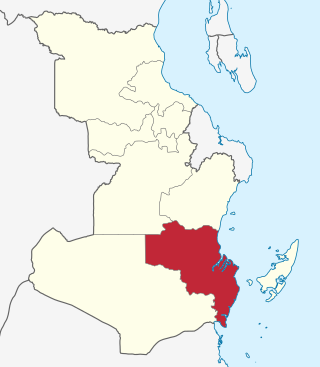
Kibiti District Council is one of nine administrative districts of Pwani Region in Tanzania. The districts of Mkuranga District and Kisarawe District border the District to the northeast and northwest, respectively. The Mafia Channel forms the district's eastern boundary. The Rufiji District also forms a border to the south of Kibiti. The district covers an area of 2,805 km2 (1,083 sq mi). The district is comparable in size to the land area of Samoa. The district seat (capital) is the town of Kibiti. According to the 2012 census, the district has a total population of 117,752.
